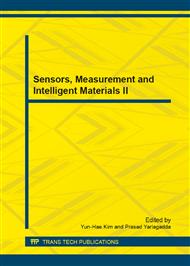[1]
D. Seharstein and R. Szeliski: J. Computer vision Vol. 47(2002),P. 7.
Google Scholar
[2]
H. Hirsehmuller: IEEE Trans. Patt. Anal. Mach. Inte. Vol. 30(2008), P. 328.
Google Scholar
[3]
H. Simon, M. Sandino and K. Reinhard, In: Half-resolution semi-global stereo matching, edited by K. Dietmayer. IEEE Intelligent Vehicles Symposium, Piscataway, NJ(2011),P. 201.
DOI: 10.1109/ivs.2011.5940427
Google Scholar
[4]
O. Veksler, In: Fast variable window for stereo correspondence using integral images, edited by E. Mortensen. Proc. of Computer Vision and Pattern Recognition. Madison(2003),P. 556.
DOI: 10.1109/cvpr.2003.1211403
Google Scholar
[5]
T. Kanada and M. Okutomi: IEEE Trans. Patt. Anal. Mach. Inte. Vol. 16(1994), P. 920.
Google Scholar
[6]
K.J. Yoon and I.S. Kweon: IEEE Trans. Patt. Anal. Mach. Inte. Vol. 28 (2006), P. 650.
Google Scholar
[7]
S.J. Lu, Z.M. Tang and L.Y. Guo: J. Engi. Grap. Vol. (2009),P. 115, In Chinese.
Google Scholar
[8]
R. Zabih and J. Woodfill, In: Non-Parametric local transforms for computing visual correspondence, edtied by J. Tsotsos. Proc. of Computer Vision. Vancouver(1994),P. 151.
DOI: 10.1007/bfb0028345
Google Scholar
[9]
M. Samadi and M.F. Othman: Adva. in Intelligent Systems and Computing Vol. 209(2013),P. 281.
Google Scholar
[10]
J.D. Simon and A. Richard: Vision Research, Vol. 40(2000),P. 1143.
Google Scholar
[11]
Z.Y. Huo X.C. Zhu and T.L. Liu: J. Scientific Instrument, Vol. 32(2011),P. 819, In Chinese.
Google Scholar
[12]
C.I. Kim and S.Y. Park, In: Fast Stereo Matching of Feature Links, edited by C. Shu. Proc. of 3D Imaging, Modeling and Processing, Vancouver(2011),P. 268.
DOI: 10.1109/3dimpvt.2011.41
Google Scholar
[13]
H.C. Li and G.J. Zhang: J. Beijing University of Aero. and Astr. Vol. 33 (2007),P. 557, In Chinese.
Google Scholar
[14]
Y.J. Xu,L.M. Du and Z.Q. Hou: ACTA ELECTRONICA SINICA, Vol. 27(1999),P. 38.
Google Scholar
[15]
P. adeh,B. Serdean and V. Cristian, In: Stereo Correspondence Matching Using Multiwavelets, edited by P. Dini. Proc. of Digital Telecommunications, Athens, IARIA(2010),P. 153.
DOI: 10.1109/icdt.2010.37
Google Scholar
[16]
M.A. Muquit,T. Shibahara and T. Aoki: Trans. Fundamentals of Electronics,Communications and Computer Sciences, Vol. 89(2006),P. 686.
Google Scholar
[17]
H.Z. Jiang, H. j. Zhao and X.Y. Liang: Opti. and Prec. Engi. , Vol. 19(2011),P. 2520, In Chinese.
Google Scholar
[18]
A.F. Bobick and S.S. Intille: J. Computer Vision, Vol. 33(1999),P. 181.
Google Scholar
[19]
S.H. Zhang Z.R. Yang and L.F. Kong: J. Scientific Instrument, Vol. 31(2010),P. 2186, In Chinese.
Google Scholar
[20]
M.L. Gong and Y.H. Yang: IEEE Trans. Patt. Anal. Mach. Inte. Vol. 27 (2005), P. 998.
Google Scholar
[21]
C. Lei,J. Selzer and Y.H. Yang, In: Region-tree based stereo using dynamic programming optimization, edited by A. Fitzgibbon. Proc. of Comp. Vision and Patt. Reco. NY (2006),P. 378.
DOI: 10.1109/cvpr.2006.251
Google Scholar
[22]
D. Arturo, X.W. Liu and E.G. Collins : IEEE Trans. Systems, Man, and Cybernetics, Part B: Cybernetics, Vol. 41 (2011),P. 183.
Google Scholar
[23]
I.J. Cox and S. Roy, In: A maximum-flow formulation of the n-camera stereo correspondence Problem, edited by W. Scheirer. Proc. of Computer Vision. Washington(1998), P492.
DOI: 10.1109/iccv.1998.710763
Google Scholar
[24]
Y. Deng, Q. Yang, X.Y. Lin, et al: IEEE Trans. Patt. Anal. Mach. Inte. Vol. 29 (2007), P. 1068.
Google Scholar
[25]
V. Kolmogorov,R. Zabin: IEEE Trans. Patt. Anal. Mach. Inte. Vol. 26 (2004), P. 147.
Google Scholar
[26]
L.T. Zhang, D.K. Qu and F. Xu: ROBOT, Vol. 32 (2010),P. 104, In Chinese.
Google Scholar
[27]
S.A. Fezza, S. Ouddane, In: Fast stereo matching via graph cuts, edited by R. Sadoun. Proc. of Workshop on Systems, Signal Processing and their Applications, Canada(2011), P. 115.
DOI: 10.1109/wosspa.2011.5931427
Google Scholar
[28]
Z.W. Zhou, J.Z. Fan, G. LI, J. Zhao: Opti. and Prec. Engineering, Vol. 21 (2013),P. 207, In Chinese.
Google Scholar
[29]
Q. Yang,L. Wang,N. Ahuja, In: A constant-space belief propagation algorithm for stereo matching , edited by E.N. Mortensen. Proc. of Computer Vision and Pattern Recognition, Washington (2010),P. 1458.
DOI: 10.1109/cvpr.2010.5539797
Google Scholar
[30]
Z.W. Zhou, J. Zhao, J. Z Fan: Opti. and Prec. Engineering, Vol. 19 (2011),P. 2774, In Chinese.
Google Scholar
[31]
J. Sun N.N. Zheng H.Y. Shum: IEEE Trans. Patt. Anal. Mach. Inte. Vol. 25 (2003), P. 787.
Google Scholar
[32]
Y. Wang, Z.J. Yu, L.Q. Zhu, L.Z. Yang: J. Scientific Instrument, Vol. 34 (2013),P. 1539, In Chinese.
Google Scholar


